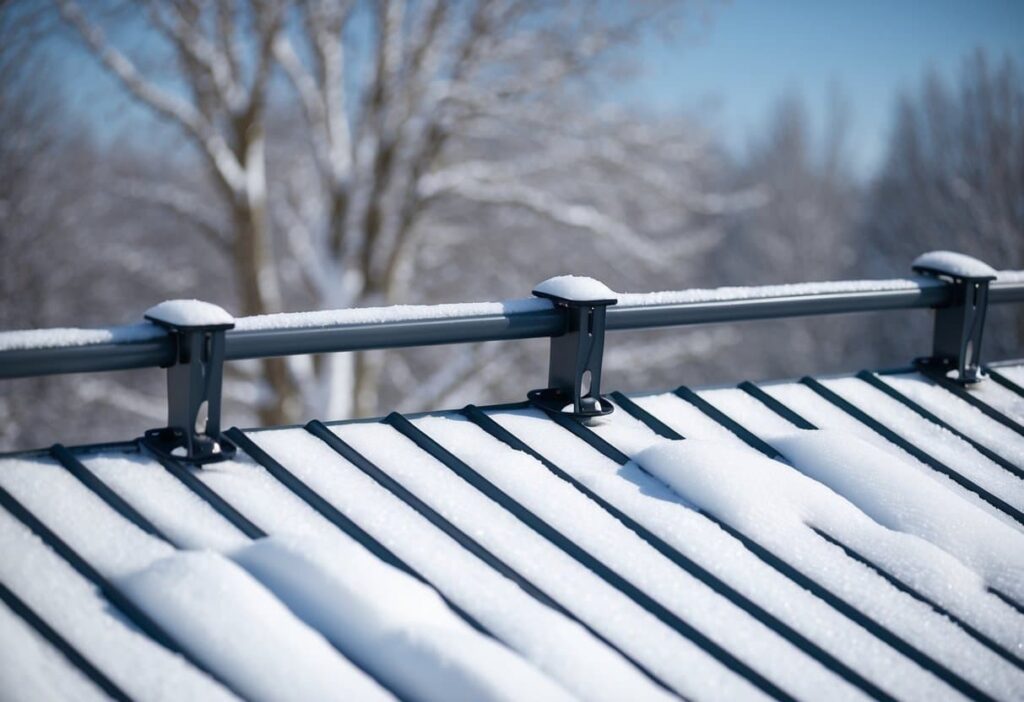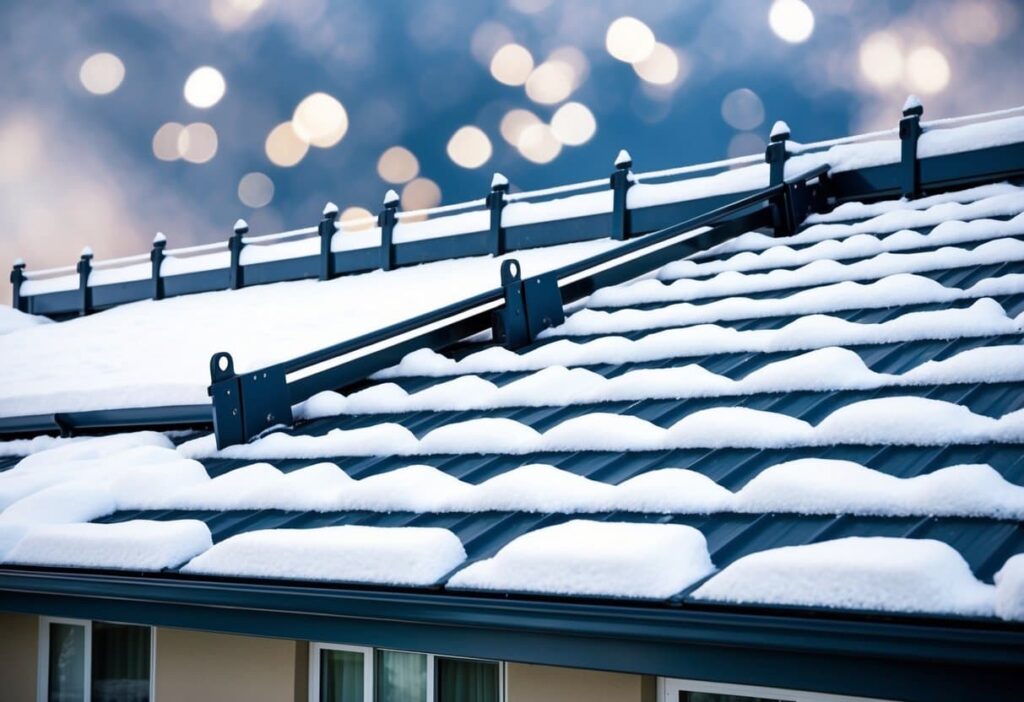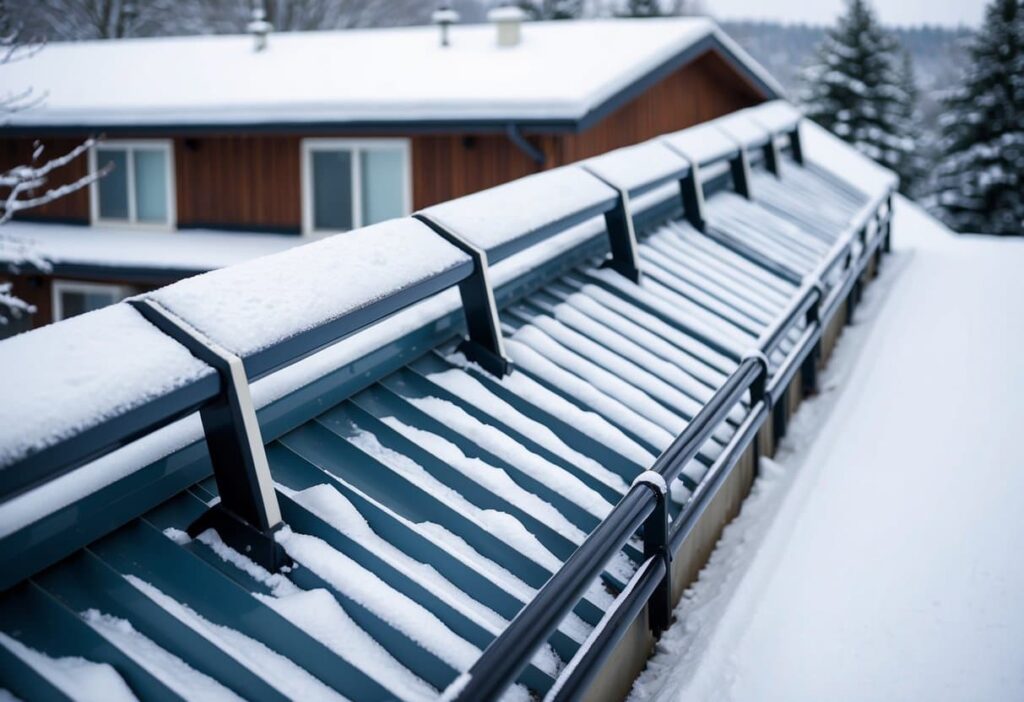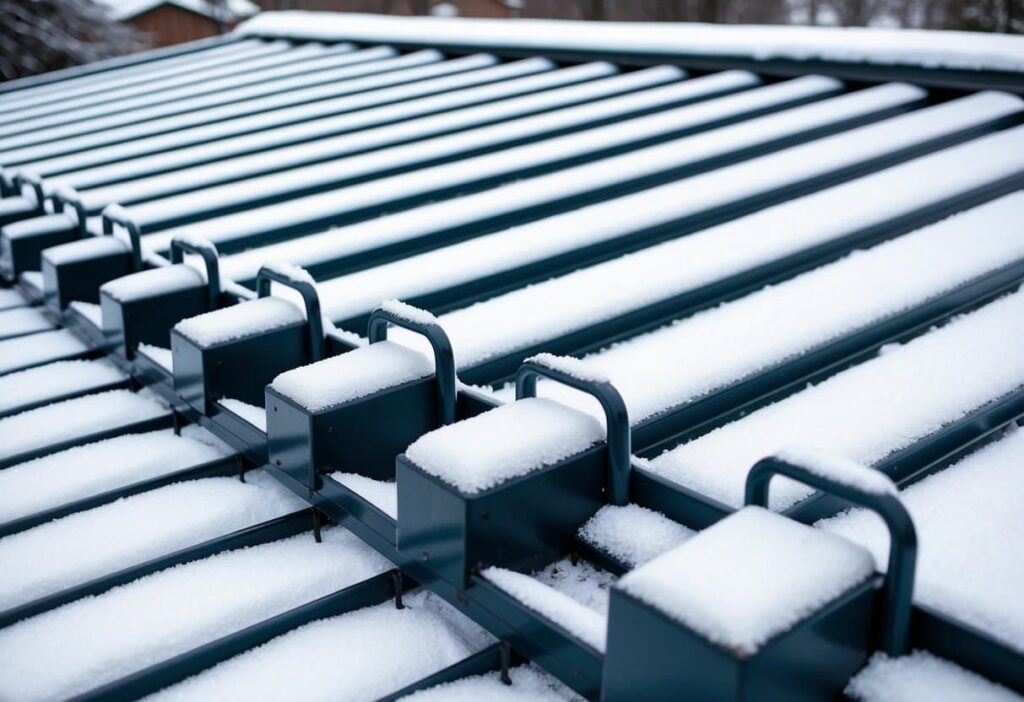Metal Roof Snow Guards vs Snow Rails: Winter Protection Systems for Canadian Homes
Winter brings snow, and it comes with the need to protect roofs and people from dangerous snow slides. Metal roofs are especially slippery, making snow guards and snow rails important safety features. It’s important to identify what your homes needs to make an accurate assessment when comparing metal roof snow guards vs snow rails.

Snow guards and snow rails both prevent snow from falling off roofs in large sheets. Snow guards are small pieces attached to the roof, while snow rails are longer bars running horizontally across the roof surface. These systems help snow melt gradually instead of sliding off all at once.
Each option has its pros and cons. Snow guards tend to be less noticeable and can work well for smaller roofs. Snow rails offer more continuous protection and may be better for areas with heavy snowfall. The choice often depends on the roof design, local weather, and personal preference.
A Brief Summary of Snow Retention
Snow retention systems help keep snow and ice from sliding off metal roofs. They protect people and property below from dangerous falling snow.
Principles of Snow Retention
Snow retention works by holding snow in place on a roof. It spreads the snow’s weight evenly across the roof surface. This stops big chunks from falling all at once.
These systems use friction and barriers to grip the snow. They also create small “dams” that block snow movement. As snow melts, it drips off slowly instead of sliding down in sheets.
Good snow retention takes into account roof pitch, local weather, and building design. The goal is to control snow melt in a safe, planned way.
Comparing Snow Guards and Snow Rails
Snow guards and snow rails are two common types of snow retention for metal roofs.
Snow guards are small devices attached in rows across a roof. They look like little fences or clamps. Snow guards work well on roofs with less pitch. They’re often cheaper and easier to install than rails.
Snow rails are long metal bars that run along the roof edge. They form a stronger barrier against sliding snow. Rails are better for steep roofs or areas with heavy snowfall. They can hold back more snow than guards.
Both options come in different styles to match roof colours. The choice between guards and rails depends on the roof and snow conditions.
How Metal Roofs Are Assessed in Snow Management
Metal roofs play a key part in managing snow buildup. Their smooth surface and design affect how snow behaves on top of buildings.
Challenges of Snow Accumulation on Metal Roofs
Metal roofs can cause snow to slide off quickly. This sudden movement of snow may harm people or things below. Big chunks of snow and ice can fall without warning. Metal roofs don’t hold onto snow like other materials do.
Snow guards or rails help control this sliding. They keep the snow in place until it melts slowly. This makes metal roofs safer in snowy areas.
Some metal roofs might be dented from heavy snow loads. Proper planning can stop this problem. Stronger metals or special designs can handle more weight.
Impact of Roof Pitch and Design
The slope of a metal roof changes how snow acts on it. Steeper roofs make snow slide off faster. Flatter roofs let snow build up more.
Roof shape matters too. Valleys between roof sections can trap snow. This may lead to ice dams. Smooth, simple roof designs work best for shedding snow.
The type of metal used affects snow behaviour. Steel roofs might hold snow differently than aluminum ones. Some finishes are slipperier than others.
Proper design can help metal roofs manage snow well. The right pitch and style can make snow removal easier and safer.
Installation & Maintenance Considerations
Snow guards and rails need proper setup and care to work well. The right approach keeps them effective and long-lasting on metal roofs.
Professional Installation vs. DIY
Having experts install snow guards or rails is often best. They know where to put them for top performance. Pros have the right tools and skills to attach them safely. DIY can save money but risks mistakes. Wrong placement can lead to roof leaks or damage. It may also make the snow guards less effective.
Homeowners who choose DIY should research carefully. They need to follow maker’s instructions exactly. This includes using the right fasteners and sealants. Proper spacing is key for the devices to work well.
Maintenance of Snow Retention Devices
Snow guards and rails need regular checks. Look for loose parts or damage after big storms. Replace any broken pieces right away. Clean off dirt, leaves, and other debris. This helps them work better and last longer.
For painted devices, touch up chips to prevent rust. Make sure sealants around fasteners are in good shape. Re-apply if they’re cracking or peeling. This stops water from getting under the roof.
Regular Inspections and Durability
Check snow retention devices each fall before winter. Look for signs of wear or shifting. Tighten any loose parts. Make sure they’re still firmly attached to the roof.
Most snow guards and rails are built to last. Many are made of strong metals like aluminum or stainless steel. These can stand up to harsh weather for years. Some have special coatings to fight rust and UV damage.
Even durable devices may need replacement after 10-15 years. Watch for metal fatigue or coating breakdown. Replace them before they fail to keep your roof and people below safe.
Perform Assessments for Safety and Effectiveness

Snow guards and snow rails play a key role in protecting buildings and people from snow-related hazards. These systems help manage snow buildup and movement on metal roofs.
Preventing Avalanches and Roof Leaks
Snow guards and rails stop large amounts of snow from sliding off roofs all at once. This prevents dangerous snow avalanches that can harm people or property below. The devices hold snow in place, allowing it to melt slowly over time.
By keeping snow on the roof, these systems also help stop ice dams. Ice dams form when melting snow refreezes at roof edges. This can lead to water backing up under shingles and causing leaks. Snow guards and rails spread out the snow load evenly across the roof surface.
Both options work well to stop avalanches and leaks. Snow guards are small and blend in more. Snow rails are larger and may be better for areas with heavy snowfall.
Mitigating Risks of Sliding Snow
Snow guards and rails reduce the risks of sliding snow in different ways. Snow guards are small metal or plastic pieces attached to the roof. They create friction to slow down moving snow. Snow rails are long metal bars that block snow from sliding completely.
Both systems can be very effective when installed properly. The number and placement of guards or rails affect how well they work. Factors like roof pitch, snow amounts, and roof material are important to consider.
Snow guards may be less noticeable but can get covered by deep snow. Snow rails stay visible and effective even with lots of snow. Either choice can greatly improve safety when used correctly on metal roofs.
Economic Factors and Aesthetics

Snow guards and rails impact both the budget and look of a home. They affect costs, appearance, and property value in different ways. These systems require careful planning to balance safety and style.
Cost-Benefit Analysis for Homeowners
Snow guards and rails have upfront costs but offer long-term savings. They prevent roof damage from snow slides, which can be costly to repair. Guards are often cheaper than rails but may need more units. Rails cost more but cover larger areas.
A typical snow guard costs $3-$8 per piece. A rail system runs $20-$30 per foot. Labour adds $50-$100 per hour. The total cost depends on roof size and local weather.
Snow retention systems can lower insurance rates. They also reduce liability risks from falling snow and ice. This protects homeowners from lawsuits and medical bills.
Aesthetic Impact on Property
Snow guards and rails change a roof’s look. Guards are small and less noticeable. They come in many colours to match the roof. Rails are bigger and more visible. Some see them as an eyesore, while others like their clean lines.
Both systems can boost curb appeal in snowy areas. They show that a home is well-maintained and safe. This can lift property values, especially in mountain or lakeside settings.
Custom designs are available for historic or high-end homes. These blend in better but cost more. Some homeowners view snow systems as a design feature, not just a safety tool.
Budget Considerations for Snow Retention Systems
The budget for snow retention varies based on home size and local climate. A small cabin might need just a few guards. A large house in a snowy area could require a full rail system.
It’s wise to plan for snow retention during a new roof install. This saves on labour costs. Retrofitting an existing roof costs more but is still doable.
Cheaper plastic guards may seem tempting. But they often crack and need replacing sooner. Metal systems last longer and offer better value over time. Some companies offer financing to spread out the cost.
Types of Snow Retention Systems
Snow retention systems for metal roofs come in different styles and materials. These systems help control snow and ice buildup to protect people and property below.
Continuous vs. Discontinuous Systems
Continuous snow retention systems run along the entire roof edge. Snow fences and snow rail systems are common examples. These create a barrier that holds snow in place as it melts.
Discontinuous systems use individual snow guards spaced out on the roof. Snow brackets and snow cleats are popular choices. They work by breaking up snow sheets into smaller sections.
Both types can be effective. The best choice depends on roof design, snow loads, and climate.
Material Choices in Snow Retention
Snow retention systems come in various materials. Common options include:
- Aluminum: Lightweight and rust-resistant
- Steel: Strong and durable
- Copper: Long-lasting and develops a unique patina
- Polycarbonate: Clear plastic that blends with the roof
The material should match or complement the roof. It needs to withstand local weather conditions. Some systems use colour-matching to blend in with the roof.
The material choice affects cost, look, and longevity. It’s important to pick a system that fits the roof and building design.
Final Considerations

Choosing the right snow management system and following local regulations are key factors for safe and effective snow control on metal roofs.
Choosing the Right Snow Management Solution
Snow guards and snow rails each have their strengths. Snow guards work well for smaller roofs or areas with moderate snowfall. They’re less noticeable and can be a good choice for homes where looks matter.
Snow rails suit larger roofs or places that get lots of heavy snow. They offer stronger protection against big snow slides. Roof pitch also plays a role in the choice. Steeper roofs may need more robust systems like rails.
A roofing pro can help pick the best option. They’ll look at your roof’s size, slope, and local weather patterns. The pro will also check your roof’s structure to make sure it can handle the added weight.
Understanding Local Building Codes
Building codes vary by area. Some places have strict rules about snow management on roofs. These rules may say what type of system you need based on your roof’s size and slope.
Codes might also set standards for how strong the system must be. This ensures it can handle the expected snow loads in your area. Some regions require a pro to design or approve the snow management plan.
Not following codes can lead to fines or issues with insurance claims. It’s smart to check with local building officials before installing any system. They can explain the rules that apply to your property. Click here for Durham Regions Building Codes
Frequently Asked Questions
Snow guards and snow rails are important safety features for metal roofs in snowy climates. They help prevent dangerous snow and ice slides. Let’s look at some common questions about these systems.
What advantages and disadvantages are associated with installing snow guards compared to snow rails on a metal roof?
Snow guards are smaller and less noticeable than rails. They can be a good choice for homes where looks are important. Snow guards are also often cheaper to install.
Snow rails offer more protection against large snow loads. They work well on steeper roofs. Rails may be better for areas that get lots of heavy, wet snow.
How does the climate in Canada affect the choice between snow guards and snow rails for metal roofs?
Canada’s cold winters make snow retention crucial for metal roofs. In areas with heavy snowfall, like the Prairies or East Coast, snow rails might be best. They can handle bigger snow loads.
For milder parts of Canada, like southern Ontario or BC, snow guards might be enough. The choice depends on local snow amounts and roof pitch.
What are the cost differences between implementing snow guards and snow rails on metal roofs?
Snow guards are usually cheaper to buy and install than snow rails. A typical snow guard system might cost $5 to $10 per square foot of roof area.
Snow rails can cost $15 to $25 per square foot or more. The higher price comes from stronger materials and more complex installation.
Which snow guard systems are considered the most effective for metal roofing?
Clamp-on snow guards work well for standing seam metal roofs. They don’t need holes drilled in the roof, which helps prevent leaks.
For other metal roof types, screw-down snow guards are effective. These attach directly to the roof panels.
Colour-matched snow guards blend in with the roof for a neat look.
At what point on a metal roof should snowguards be installed for optimal performance?
Snow guards work best when placed near the roof’s edge. They should be installed in a pattern across the lower third of the roof.
For longer roof planes, extra rows of guards may be needed higher up. This helps manage snow loads better.
The exact layout depends on the roof pitch, local snow loads, and the specific guard type.
What are the chief differences between a snow guard and a snow fence on metal roofing systems?
Snow guards are small, individual units attached to the roof. They’re spaced out to catch and hold snow in place.
Snow fences, also called snow rails, are continuous barriers that run along the roof edge. They stop large sheets of snow from sliding off at once.
Snow fences offer more protection but are more visible. Snow guards are less noticeable but may not stop as much snow.
